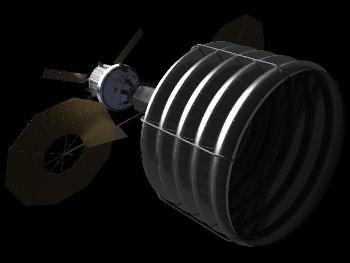Apr 11 2013
The following are statements from the associate administrators of NASA's Human Exploration and Operations Mission Directorate, Science Mission Directorate and Space Technology Mission Directorate on the administration's budget request for the 2014 fiscal year.
 By leveraging capabilities across all of NASA, the agency is developing a first-ever mission to identify, rendezvous with, capture and redirect a small asteroid into a stable orbit in the lunar vicinity, and then send humans to visit it using the Space Launch System rocket and Orion spacecraft. This image represents a notional spacecraft with its asteroid capture mechanism deployed. Image Credit: NASA/Advanced Concepts Lab
By leveraging capabilities across all of NASA, the agency is developing a first-ever mission to identify, rendezvous with, capture and redirect a small asteroid into a stable orbit in the lunar vicinity, and then send humans to visit it using the Space Launch System rocket and Orion spacecraft. This image represents a notional spacecraft with its asteroid capture mechanism deployed. Image Credit: NASA/Advanced Concepts Lab
From Associate Administrator for Human Exploration and Operations William Gerstenmaier :
"The mission to find, capture and redirect an asteroid robotically, and then visit it with astronauts to study it and return samples takes advantage of expertise across all of NASA in an integrated approach to exploration. Along with the scientific research and technology demonstrations happening around the clock on the International Space Station that are teaching us how humans can live and work in space, this mission will give us valuable experience we need in deep space operations to send humans to more distant destinations in the solar system, including Mars. Through the balance of this fiscal year, we will work to define an affordable mission architecture. In Fiscal Year 2014, NASA will begin developing and testing prototype capture mechanisms and concepts for crew interactions with the asteroid."
From Associate Administrator for Science John Grunsfeld:
"The crucial first step in this endeavor is to enhance our ongoing efforts to identify and characterize near-Earth objects for scientific investigation and to find potentially hazardous asteroids and targets appropriate for capture. The capture mission will be a highly visible and significant collaboration of robotic and human exploration in translunar space."
From Associate Administrator for Space Technology Michael Gazarik:
"This mission accelerates our technology development activities in high-powered solar electric propulsion. The ambitious mission to rendezvous, capture and redirect a small asteroid to Earth-moon space could not be accomplished without solar electric propulsion technology. This technology also will support the commercial telecommunications and satellite industries, and is an essential step toward future NASA human and robotic exploration forays into deep space."
The NASA budget and supporting information are available at: http://www.nasa.gov/budget